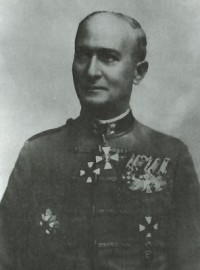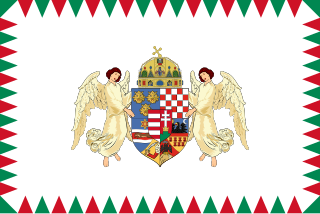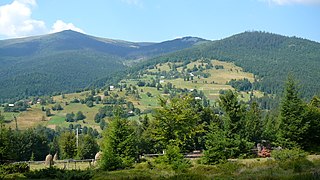
Ferenc Szálasi was the leader of the Arrow Cross Party – Hungarist Movement, the "Leader of the Nation" (Nemzetvezető), being both Head of State and Prime Minister of the Kingdom of Hungary's "Government of National Unity" for the final six months of Hungary's participation in World War II, after Germany occupied Hungary and removed Miklós Horthy by force. During his brief rule, Szálasi's men murdered 10,000–15,000 Jews. After the war, he was tried and executed by the Hungarian court for war crimes and crimes against humanity committed during World War II.
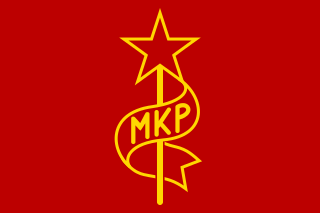
The Party of Communists in Hungary, renamed Hungarian Communist Party in October 1944, was founded on November 24, 1918, and was in power in Hungary briefly from March to August 1919 under Béla Kun and the Hungarian Soviet Republic. The communist government was overthrown by the Romanian Army and driven underground. The party regained power following World War II and held power from 1945 under the leadership of Mátyás Rákosi. In 1948 the party merged with the Social Democrats to become the Hungarian Working People's Party. The Communist Party of Hungary was a member of the Communist International.

Béla Miklós de Dálnok, Vitéz of Dálnok was a Hungarian military officer and politician who served as acting Prime Minister of Hungary, at first in opposition, and then officially, from 1944 to 1945. He was the last Prime Minister of war-time Hungary.

The Lvov–Sandomierz Offensive or Lvov-Sandomierz Strategic Offensive Operation was a major Red Army operation to force the German troops from Ukraine and Eastern Poland. Launched in mid-July 1944, the Red Army achieved its set objectives by the end of August.

Magyar Testgyakorlók Köre is a multi-sports club from Budapest, founded in 1888. It has sections for football, handball, basketball, volleyball, futsal, ice hockey, water polo, cycling, gymnastics, athletics, fencing, canoeing, boxing, wrestling, swimming, rowing, karate, taekwondo, sailing, speed skating, skiing, table tennis, tennis and chess.

Hungary competed at the 1964 Summer Olympics in Tokyo, Japan. 182 competitors, 150 men and 32 women, took part in 111 events in 17 sports.

The Hungarian Second Army was one of three field armies (hadsereg) raised by the Kingdom of Hungary which saw action during World War II. All three armies were formed on March 1, 1940. The Second Army was the best-equipped Hungarian formation at the beginning of the war, but was virtually eliminated as an effective fighting unit by overwhelming Soviet force during the Battle of Stalingrad, suffering 84% casualties. Towards the end of the war, a reformed Second Army fought more successfully at the Battle of Debrecen, but, during the ensuing Siege of Budapest, it was destroyed completely and absorbed into the Hungarian Third Army.
The Gyorshadtest was the most modern and best-equipped mechanized unit of the Royal Hungarian Army at the beginning of World War II. However, the "Rapid Corps" name was something of a misnomer as it was only "mechanized" compared to other Hungarian units. The corps was not particularly mechanized when compared to similar units fielded by countries like Germany or the Soviet Union.

During World War II, the Kingdom of Hungary was a member of the Axis powers. In the 1930s, the Kingdom of Hungary relied on increased trade with Fascist Italy and Nazi Germany to pull itself out of the Great Depression. Hungarian politics and foreign policy had become more stridently nationalistic by 1938, and Hungary adopted an irredentist policy similar to Germany's, attempting to incorporate ethnic Hungarian areas in neighboring countries into Hungary. Hungary benefited territorially from its relationship with the Axis. Settlements were negotiated regarding territorial disputes with the Czechoslovak Republic, the Slovak Republic, and the Kingdom of Romania. In 1940, Hungary joined the Axis powers. The following year, Hungarian forces participated in the invasion of Yugoslavia and the invasion of the Soviet Union. Their participation was noted by German observers for its particular cruelty, with occupied peoples subjected to arbitrary violence. Hungarian volunteers were sometimes referred to as engaging in "murder tourism."
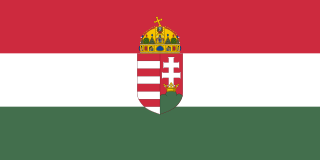
The Kingdom of Hungary, sometimes referred to as the Regency or the Horthy era, existed as a country from 1920 to 1946 under the rule of Regent Miklós Horthy. Horthy officially represented the Hungarian monarchy of Charles IV, Apostolic King of Hungary. Attempts by Charles IV to return to the throne were prevented by threats of war from neighbouring countries and by the lack of support from Horthy.

The Government of National Unity existed during the occupation of Hungary by Nazi Germany between October 1944 and May 1945. Formed by the Nazi Arrow Cross Party, it was established on 16 October 1944 after Regent Miklós Horthy was removed from power during Operation "Panzerfaust". Arrow Cross leader Ferenc Szálasi became Prime Minister and, as "Nation Leader", the head of state. During the government's short period of rule, ten to fifteen thousand Jews were murdered in Hungary and around eighty thousand Jews, including many women, children and elderly Jews, were deported from Hungary to their deaths in the Auschwitz concentration camp.

Vilmos Nagy de Nagybaczon, was a commanding general of the Royal Hungarian Army (1920–1945), Minister of Defence, a military theorist and historian.
Arthur Hauffe was a German general during World War II and commanded the XIII Army Corps. He was recipient of the Knight's Cross of the Iron Cross of Nazi Germany.
Yefim Vikentyevich Baranovich was an Imperial Russian and Soviet career military officer whose service spanned the Russo-Japanese War, World War I, the Russian Civil War and the concurrent Polish-Soviet War, and World War II.
Béla Nagy Abodi was Hungarian painter, and professor of the Academy of Fine Arts in Cluj-Napoca.
Kálmán Kéri was a Hungarian military officer and politician.
Vilmos Tartsay, was a military officer who took part in the Hungarian resistance movement in the Second World War.

The Western Carpathian Offensive was a successful offensive by the Red Army during World War II, that lasted from January 12 to February 18, 1945.



